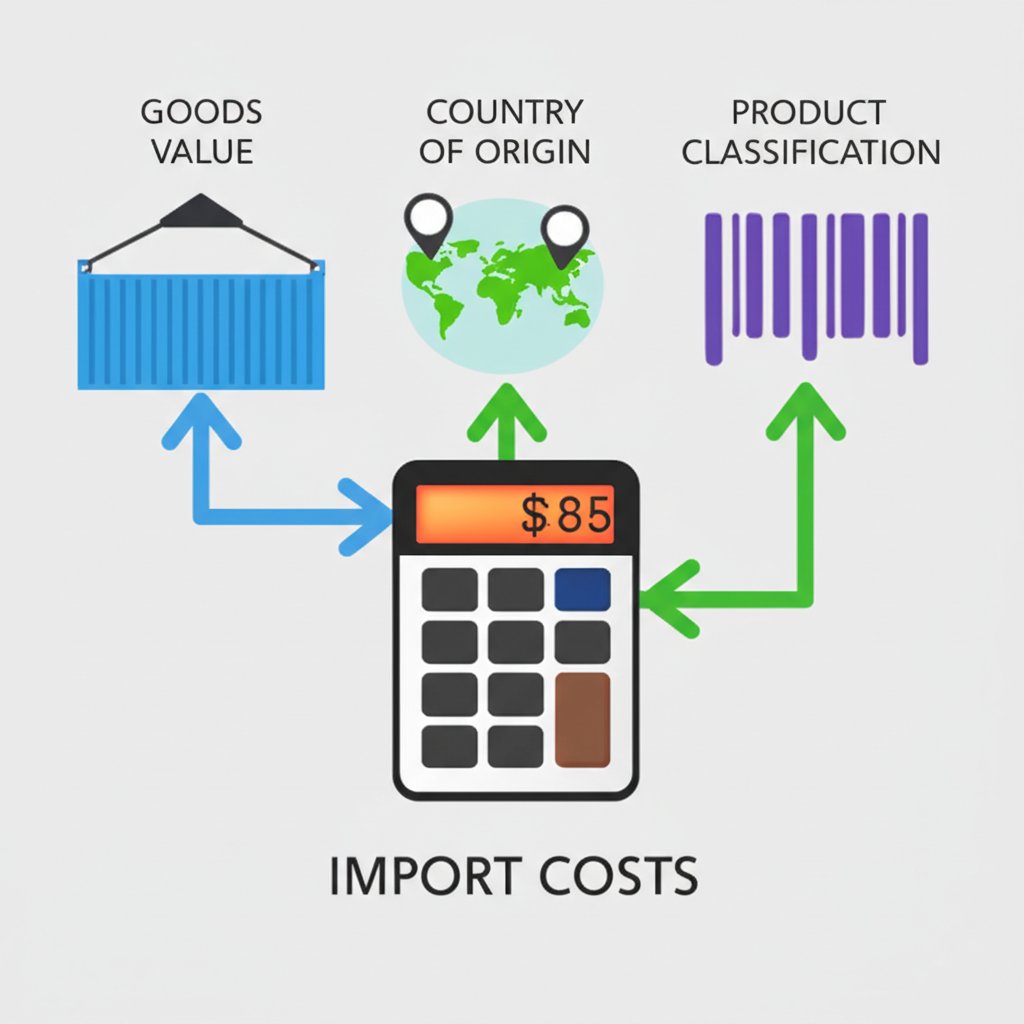
What Is an EU Customs Duty Calculator and Why Does It Matter?
Ever wondered why some shipments into the European Union arrive smoothly, while others face costly delays or unexpected charges? The answer often lies in how well you estimate your import costs. That’s where the EU customs duty calculator comes into play—a digital tool designed to help importers and businesses predict the total charges when bringing goods into the EU. Sounds complex? Not when you have the right tools and know-how.
The Essential Role of Duty Calculators in International Trade
Picture this: you’re sourcing products from outside the EU and need to budget for the entire journey—from factory to warehouse. If you get the numbers wrong, you could face surprise bills, compliance headaches, or even shipment holds at customs. An import duty calculator free solution takes the guesswork out of this process by instantly estimating the customs duties, VAT, and other taxes you’ll owe. This helps prevent budget overruns and keeps your supply chain running smoothly.
- Accurate Budgeting: Plan your costs upfront—no more nasty surprises.
- Regulatory Compliance: Ensure you pay the right amount and meet EU customs requirements.
- Faster Shipments: Avoid customs delays caused by incomplete or incorrect paperwork.
What Does an EU Customs Duty Calculator Actually Do?
At its core, this calculator uses three main pieces of information to estimate your import taxes:
- Value of the goods: The declared customs value, including cost, shipping, and insurance.
- Product classification: The correct tariff code or HS code assigned to your goods.
- Country of origin: Where your goods are manufactured or produced.
Each of these elements is essential. For example, the customs value is not just the purchase price—it often includes shipping and insurance costs as well. The HS code determines the applicable customs duty rate, and the country of origin can affect whether preferential rates or trade agreements apply (EU Taxation and Customs Union).
Why Understanding the Calculation Matters
Imagine importing electronics from Asia. If you misclassify your goods or underestimate their value, you could end up paying more than necessary—or worse, face fines for non-compliance. By understanding what goes into the calculation, you can:
- Accurately predict total landed costs, including customs duty and VAT
- Make informed decisions about sourcing and pricing
- Ensure your shipments clear customs without delay
What to Expect in This Guide
In this article, you’ll discover:
- How an EU customs duty calculator works step by step
- The breakdown of total import costs: customs duty, VAT, and other fees
- The critical importance of using the correct HS code
- Common mistakes to avoid when estimating duties
- Strategies to potentially reduce your EU import duty burden
- Pro tips for compliance and risk reduction
Ready to master the numbers and import with confidence? Let’s dive deeper into how these calculators work and how you can use them to your advantage.

How an EU Customs Duty Calculator Works
When you’re preparing to import goods into the European Union, you might ask: How does an EU customs duty calculator international tool actually work? The answer lies in the details you provide—and the precision with which those details are processed. Imagine standing at the start of a global supply chain, trying to predict every euro you’ll spend. A reliable duties and taxes calculator takes the guesswork out, but only if you supply the right information.
The Essentials: What Information Do You Need?
To deliver an accurate estimate, every calculator relies on three core data points. These aren’t just bureaucratic hurdles—they’re the foundation for getting your import costs right and avoiding headaches at customs.
- Value of Goods (CIF Value): This isn’t just the invoice price. It includes the cost of the goods, international shipping, and insurance. Customs authorities use the CIF (Cost, Insurance, and Freight) value to ensure all import-related expenses are captured. Getting this wrong can mean underpaying or overpaying duties (WeFreight).
- Country of Origin: Where were the goods produced or manufactured? The country of origin determines whether trade agreements, tariff quotas, or preferential rates apply. A Certificate of Origin may be required to prove this.
- Product Classification (HS Code): Every product is assigned a Harmonized System (HS) code. This code is crucial—it tells customs exactly what you’re importing and what duty rates apply. The wrong HS code can lead to incorrect charges or even legal issues (EU Taxation and Customs Union).
Step-by-Step: From Data Entry to Duty Estimate
Let’s break down the process you’ll follow with a typical EU customs duty calculator:
- Step 1: Gather Documentation
Before you start, collect your commercial invoice, bill of lading, certificate of origin, and insurance documents. These will provide all the necessary details for entry. - Step 2: Enter the Value of Goods
Input the CIF value—add up the product price, shipping, and insurance. This forms the base for customs valuation. - Step 3: Specify the Country of Origin
Select or enter the country where the goods were made. This affects duty rates and eligibility for preferential treatment. - Step 4: Input the HS Code
Find and enter the correct HS code for your product. If you’re unsure, consult the EU’s TARIC database or seek expert advice. - Step 5: Review Calculated Duties and Taxes
The calculator processes your information, referencing official EU tariff schedules and rules of origin. It then displays estimated customs duty, VAT, and other applicable taxes.
Why Each Field Matters
Each input isn’t just a box to check—it’s a critical variable in your total import cost:
- Accurate value: Ensures you’re not under- or overpaying duties and VAT.
- Correct origin: Determines eligibility for reduced rates under trade agreements.
- Precise HS code: Matches your product to the exact duty rate and regulatory requirements.
With these steps, you’ll notice that the duties and taxes calculator doesn’t just spit out a number—it guides you through a process designed for compliance and cost control. Next, we’ll break down the specific charges you’ll see on your import invoice, so you can see exactly where your money goes.
Deconstructing the Total Cost
When you use an EU customs duty calculator, you might wonder: Where does each euro of your import cost actually go? The answer is a blend of different charges—each with its own rules and impact on your bottom line. Let’s break down the main components, so you can accurately calculate import duties and avoid surprises.
Understanding the Main Charges on Your Import Invoice
Every time you import goods from outside the EU, your total cost is made up of several layers. Here’s what you’ll typically encounter:
- Customs Duty: This is the core charge based on the product’s classification (HS or TARIC code) and its country of origin. The EU sets common import duty rates by country and product type, which you can check in the TARIC database. For example, electronics often have a 0% duty, while clothing or shoes may incur higher rates.
- Import VAT (Value Added Tax): VAT is charged on the total customs value plus customs duty and any other applicable taxes or fees. The standard VAT rate in most EU countries is around 21%, but it can vary by country and product category (EU Taxation and Customs).
- Excise Duties: These are extra taxes on specific goods like alcohol, tobacco, or energy products. Excise rates vary by country and are set in addition to customs duty and VAT.
- Anti-Dumping Duties: Sometimes, goods from certain countries are subject to extra tariffs to protect EU industries. These are product- and country-specific and can significantly increase your costs.
- Carrier Handling and Customs Clearance Fees: Postal operators, couriers, or customs brokers may charge administrative fees for processing your shipment through customs. These vary by provider and are usually listed separately on your invoice.
Sample Calculation: How Do These Charges Add Up?
Let’s make this real with an example. Imagine you’re importing a shipment of glasses (eyewear) from a non-EU country. Here’s a step-by-step breakdown of how the total landed cost is calculated:
| Cost Component | Calculation | Amount (€) |
|---|---|---|
| Product Cost | – | 10,000 |
| Shipping & Insurance | – | 2,000 |
| Customs Value | Product Cost + Shipping & Insurance | 12,000 |
| Import Duty (11%) | Customs Value x Duty Rate | 1,320 |
| Import VAT (21%) | (Customs Value + Import Duty) x VAT Rate | 2,793.60 |
| Carrier Handling Fee | – | 50 |
| Total Landed Cost | Sum of all above | 16,163.60 |
With this example, you can see how each charge builds on the last. The customs value forms the base, import duty is calculated on that base, and VAT is then charged on the total of both. Carrier fees and other possible surcharges are added at the end.
What About Special Cases?
- Low-Value Shipments: If the value of your goods (excluding shipping and insurance) is €150 or less, you typically won’t pay customs duty, but VAT and handling fees may still apply.
- Excise Products: For alcohol, tobacco, or energy products, excise duties are always due, regardless of value. You’ll get a separate invoice for these from customs or your carrier (EU Taxation and Customs).
- Anti-Dumping Measures: Certain goods, like steel or bicycles from specific countries, may face extra duties. Always check the TARIC database for the latest rules.
Key Takeaways for Accurate Import Cost Calculation
- Always use the correct HS or TARIC code to find the right duty rate.
- Include shipping and insurance in your customs value.
- Check the VAT rate for your destination country and product type.
- Don’t forget possible carrier or administrative fees.
By understanding each charge, you can confidently use an EU customs duty calculator to estimate your true import costs. Next, we’ll explore why getting your product classification right is so essential—and how one small mistake can have big consequences for your shipment and your budget.

The Critical Role of Accurate Product Classification (HS Codes) in EU Duty Calculation
Ever wondered why two seemingly identical shipments can face different customs charges or delays at the EU border? The answer often comes down to one detail: the HS code. If you’re using an HS code customs calculator or checking the EU customs tariff, you’ll notice that everything hinges on getting this code right. But what exactly is an HS code, and why does it carry so much weight in your customs duty calculation?
What Is an HS Code and How Does It Work?
Imagine the HS code as a global product language—a unique number that tells customs exactly what’s inside your shipment. The Harmonized System (HS) is an international standard developed by the World Customs Organization. It breaks down every product into a numerical hierarchy, starting with broad categories and drilling down to precise details. Here’s how it’s structured:
- HS 6-digit code: The universal base, recognized worldwide.
- CN 8-digit code: The EU’s version, adding two digits for extra specificity.
- TARIC 10-digit code: The EU’s most detailed level, used for regulatory and tariff measures.
For example, a code like 8407 10 00 20 might describe a specific type of engine for vehicles, with each level adding more detail. This precision ensures that the right duty rates and rules are applied to your goods.
Why Does Getting the HS Code Right Matter?
Assigning the correct HS code is not just a paperwork exercise—it’s the foundation of compliant and cost-effective importing. Here’s why:
- It determines the exact EU customs tariff and duty rate for your product.
- It reveals whether your goods are subject to special regulations, quotas, or health standards.
- It’s essential for customs clearance—an incorrect code can block your shipment.
- It affects eligibility for preferential trade agreements and reduced duties.
Sounds straightforward? In reality, misclassifying your product—even by a single digit—can have serious consequences.
Consequences of Incorrect HS Codes
| Risk | Impact |
|---|---|
| Penalties and Fines | Customs authorities can impose significant penalties for incorrect codes, sometimes doubling fines if the error is deemed evasive (Avalara). |
| Shipment Delays or Seizure | Misclassification can result in goods being held, delayed, or even confiscated at the border. |
| Overpayment of Duties | Using a code with a higher duty rate means you pay more than necessary—often with little chance of a refund. |
| Underpayment of Duties | If customs discovers you’ve underpaid, you’ll owe the difference plus interest and may face penalties. |
| Loss of Trade Preferences | Incorrect codes can disqualify you from reduced tariffs under EU trade agreements. |
How to Ensure You Have the Right HS Code
So, how can you confidently assign the correct code and avoid costly mistakes? Here are practical steps:
- Use Official Databases: The EU’s TARIC database is updated daily and allows you to search by product description or code.
- Consult the Combined Nomenclature (CN): For eight-digit EU codes, refer to the annual CN publication on EUR-Lex.
- Work with Experienced Customs Brokers: Experts can help interpret complex product descriptions and ensure correct classification.
- Keep Codes Updated: Nomenclatures change—always check for updates before each shipment.
- Document on All Transport Papers: With new EU security rules, include full HS codes on invoices and shipping documents to streamline clearance (Mathez Freight).
Why Pre-Shipment Inspection Matters for HS Codes
Even with the right code, documentation errors or product discrepancies can cause issues. That’s where pre-shipment inspection comes in. By verifying product details, packaging, and documentation before goods leave the factory, you can catch misclassifications early—saving time, money, and hassle at customs. For a deeper dive into how pre-shipment inspection supports accurate customs declarations and reduces risk, check out this expert guide from Eagle Eyes.
Getting your HS code right is the linchpin of a smooth, cost-effective import process. Next, let’s explore the most common mistakes importers make with duty calculators—and how you can avoid them for seamless EU customs clearance.
Common Mistakes When Using an EU Customs Duty Calculator
When you use an EU customs duty calculator, it’s tempting to think you’ll get a perfect answer every time. But have you ever noticed unexpected costs or shipment delays, even after careful calculations? The truth is, a calculator is only as good as the information you enter. Let’s break down the most frequent mistakes importers make—and how you can sidestep them to ensure accurate, compliant, and cost-effective importing, whether you’re shipping from the USA or anywhere else.
Top Mistakes That Skew Your Import Duty Calculations
Imagine you’re importing goods into the EU for the first time. You enter your numbers, hit “calculate,” and expect smooth sailing. But a few weeks later, customs holds your shipment, or you receive a surprise bill. Where did things go wrong? Here’s a checklist of pitfalls that trip up even experienced importers when using an EU customs duty calculator USA or similar tools:
- Incorrect Valuation of Goods
• Only entering the purchase price and forgetting shipping, insurance, and handling costs means your customs value EU is too low. Customs authorities require the full CIF (Cost, Insurance, Freight) value. Under- or over-valuing can trigger fines, shipment holds, or extra scrutiny. - Confusing Country of Origin and Country of Dispatch
• The country of origin is where goods are manufactured, not where they’re shipped from. Mixing these up can lead to wrong duty rates, missed out on preferential trade agreements, or even rejection of your shipment. - Ignoring Low-Value Thresholds
• Did you know goods valued at €150 or less (excluding shipping and insurance) are typically exempt from customs duty, though VAT and handling fees may still apply? Failing to recognize this can mean overpaying or unnecessary paperwork. - Misunderstanding Incoterms
• Incoterms define who pays for shipping, insurance, and customs clearance. If you misinterpret these, you might exclude key costs from your customs value or misunderstand your financial responsibilities, leading to disputes or unexpected charges. - Using Outdated Duty Rates
• Duty rates and regulations change frequently. Relying on last year’s numbers or outdated online calculators can result in incorrect estimates and customs refusals. Always check the latest rates using official EU resources or digital platforms that provide real-time updates. - Incorrect HS Code Assignment
• Entering the wrong product code means the calculator applies the wrong duty rate—resulting in overpayment, underpayment, or even shipment seizure. Double-check your HS code using the TARIC database or consult an expert. - Incomplete or Inaccurate Documentation
• Missing invoices, packing lists, or certificates of origin can stall customs clearance, no matter how accurate your calculation. Every detail must match your customs declaration.
How Pre-Shipment Inspections Help You Catch Errors Early
Now, imagine if you could spot most of these mistakes before your goods ever left the factory floor. That’s where pre-shipment inspections come in—a crucial step often overlooked in the rush to ship. A pre-shipment inspection (PSI) is a systematic, on-site review of your goods and paperwork before export. Here’s how it can save you from costly missteps:
- Verification of Product Details: Inspectors check that goods match descriptions, labels, and HS codes, preventing misclassification and customs delays.
- Document Review: All shipping, commercial, and regulatory documents are cross-checked for accuracy, ensuring the declared customs value EU and country of origin are correct.
- Compliance Assurance: PSIs confirm that your goods meet EU standards and that all paperwork aligns, reducing the risk of shipment rejection or extra duties.
- Early Error Detection: By catching discrepancies at the source, you avoid last-minute surprises, costly rework, or even total loss of your shipment.
For a detailed walkthrough of how PSI works and why it’s essential for risk mitigation, check out this expert guide from Eagle Eyes. It’s a game-changer for importers who want to ensure their calculations are based on accurate, compliant data—and to protect every euro invested in their supply chain.
“A single missed detail in your customs declaration can cost far more than the duty itself. Pre-shipment inspections are your best defense against costly errors and shipment delays.”
Checklist: How to Avoid Common EU Customs Duty Calculator Mistakes
- Always use up-to-date duty rates and regulations.
- Include all shipping, insurance, and handling costs in your customs value.
- Double-check the country of origin—don’t confuse it with the country of dispatch.
- Verify product classification with the correct HS code.
- Understand Incoterms and their impact on cost responsibility.
- Maintain complete and accurate documentation for every shipment.
- Consider a pre-shipment inspection to catch errors before goods leave the factory.
By mastering these steps, you’ll not only avoid common pitfalls but also set the stage for smoother customs clearance and more predictable import costs. Next, let’s look at ways to legally reduce your EU import duty burden and maximize your cost savings.

Smart Strategies to Reduce Import Duty in the EU
When you look at your import invoice, do you ever wonder if there’s a way to reduce import duty EU charges without cutting corners? The good news: there are legitimate strategies—some built right into the EU’s own customs framework—that can help you save money and stay compliant. Let’s walk through the most effective ways to lighten your customs duty burden, so you can keep your business competitive.
1. Leverage Preferential Trade Agreements for Lower Duties
Did you know that the country where your goods are made can sometimes unlock significant savings? The EU has signed a network of preferential trade agreements with many countries and regions. These agreements allow goods that meet specific origin criteria to enter the EU at reduced or even zero customs duty rates. But there’s a catch: you must prove your goods qualify for preferential origin status, usually with a certificate or declaration of origin (EU Taxation and Customs Union).
- Check if your supplier’s country has a preferential trade agreement EU-wide. The official EU customs website lists current agreements and qualifying countries.
- Meet the origin rules. These are specific to each agreement and product—often requiring a percentage of local content or certain manufacturing processes.
- Collect and retain the right proof. A valid certificate of origin or approved exporter statement is essential for claiming reduced duties at import.
Imagine you’re importing apparel from a country covered by the EU’s Generalised Scheme of Preferences (GSP). If you ensure your products meet the origin rules and have the correct documentation, you could pay a much lower duty—or none at all.
2. Explore Tariff Suspensions and Quotas
Sometimes, the EU temporarily suspends or reduces duties on certain raw materials, components, or products that aren’t widely available within the Union. These are known as tariff suspensions or autonomous tariff quotas. They’re especially valuable for manufacturers and assemblers:
- Tariff suspensions: Eliminate or reduce duty rates for a set period, often to support EU industry needs.
- Tariff quotas: Allow a specific volume of goods to be imported at a lower or zero rate until the quota is filled.
To take advantage, keep an eye on the EU’s official notices or consult your customs broker for the latest updates. Applying for these benefits usually means submitting extra paperwork, but the savings can be substantial—especially for high-value or bulk shipments.
3. Use Special Customs Procedures: Inward Processing and Customs Warehousing
What if you could import goods, process or store them in the EU, and only pay duties if and when they enter the local market? That’s exactly what special customs procedures offer:
- Inward Processing: Lets you import non-EU goods for manufacturing or repair without paying import duty or VAT upfront. If you re-export the finished products, you may avoid duties altogether. If you release them for sale in the EU, duties apply only then (EU Taxation and Customs Union).
- Customs Warehousing: Store imported goods in a customs-approved warehouse without paying duties or VAT until the goods are released for free circulation within the EU.
These procedures require prior authorization from customs authorities and careful record-keeping, but they offer powerful cash flow advantages and flexibility—especially for businesses with fluctuating demand or complex supply chains.
4. Consider Tariff Reclassification—But Only When Justified
Sometimes, a product can be classified under more than one HS code, each with different duty rates. Careful, accurate classification—based on product composition and use—may legally qualify your goods for a lower rate. However, never force a reclassification just to save duties; always base your decision on documented product details and official tariff guidance. Consulting a customs expert or using the EU’s TARIC database can help clarify your options.
Quick Tips for Maximizing Duty Savings
- Review your supply chain for opportunities to source from countries with preferential agreements.
- Stay updated on tariff suspensions and quotas relevant to your industry.
- Apply for inward processing or customs warehousing if your business model supports it.
- Double-check product classification for accuracy and compliance.
By exploring these strategies, you can legally reduce your import duty burden and improve your bottom line. Next, we’ll wrap up with a summary of key insights and show how smart planning—plus robust pre-shipment inspections—can make your importing process both compliant and cost-effective.
Conclusion
When you think about the EU customs clearance process, do you picture endless paperwork, surprise fees, and the risk of costly delays? It doesn’t have to be that way. By applying the import duty calculation tips covered throughout this guide, you can turn what seems like a maze into a manageable, even strategic, part of your business.
Key Takeaways for Accurate and Compliant Importing
- Precision is everything: Every euro counts, so double-check the customs value, country of origin, and HS code for every shipment. These three details form the backbone of any EU customs duty calculator and directly influence your final costs.
- Stay up to date: Customs regulations, duty rates, and VAT percentages change frequently. Make it a habit to consult official EU resources or trusted customs experts before every new import.
- Understand the total cost: Don’t just focus on the duty itself. Factor in VAT, excise duties, anti-dumping measures, and carrier fees. A clear breakdown helps you budget accurately and avoid surprises at customs.
- Leverage trade agreements and special procedures: Preferential trade deals, tariff suspensions, and customs warehousing can all reduce your duty burden—if you know how to use them.
Strategic Planning: Your Edge in EU Import Success
Imagine being able to forecast your landed costs with confidence, make informed sourcing decisions, and negotiate better with suppliers. That’s the power of mastering these calculation tips and integrating them into your import planning. Not only does this boost your competitiveness, but it also helps you avoid compliance risks and costly shipment holds.
But here’s a critical insight: even the most accurate calculation is only as reliable as the data and documentation behind it. That’s where many importers stumble—especially when products don’t match paperwork, or when regulatory requirements are overlooked. So, what’s the next step to truly safeguarding your investment?
Why Pre-Shipment Inspections Are the Missing Link
Think of pre-shipment inspections as your final quality and compliance checkpoint before goods leave the factory. This step isn’t just about catching defects—it’s about verifying that every detail on your invoice, packing list, and certificates matches what’s actually being shipped. When you conduct a thorough pre-shipment inspection, you:
- Ensure product quality and compliance with EU standards
- Catch discrepancies in HS codes, values, or origin declarations before they become customs problems
- Minimize the risk of shipment rejections, fines, or costly delays at the border
- Protect your bottom line by ensuring the goods you pay duty on are exactly what you ordered
If you want a step-by-step guide to making pre-shipment inspections work for your business, don’t miss this expert resource from Eagle Eyes. It breaks down how PSI can be seamlessly integrated into your import workflow, providing peace of mind and real risk mitigation for every shipment.
“The best import duty calculation is worthless if your shipment fails quality checks or is rejected at customs. Pre-shipment inspection bridges the gap between calculation and reality—making your import process both compliant and cost-effective.”
Final Thoughts: Turn Complexity into Opportunity
Mastering the EU customs duty calculator isn’t just about crunching numbers—it’s about building a resilient, cost-efficient import strategy. By focusing on accuracy, staying informed, and incorporating pre-shipment inspections, you’ll not only streamline the EU customs clearance process but also protect your investment from preventable risks. The next time you plan an import, remember: smart calculation and proactive inspection are your best allies for success in the EU market.
EU Customs Duty Calculator FAQs
1. Do I have to pay duty on items shipped from USA to Europe?
Yes, when shipping goods from the USA to the EU, you must pay customs duties and VAT on all shipments. Since July 2021, every package entering the EU requires a formal customs declaration, and VAT applies regardless of value. Using an EU customs duty calculator helps estimate these charges upfront and ensures you comply with updated regulations, avoiding unexpected costs or shipment holds.
2. What is the EU common customs tariff?
The EU common customs tariff (CCT) is a unified set of import duty rates applied across all EU member states for goods entering from outside the EU. Duty rates vary based on product classification and country of origin. The CCT ensures consistency in customs procedures and can be checked using the EU’s TARIC database for accurate duty calculation.
3. What is the customs value in the EU and how is it calculated?
The customs value in the EU is the total value used to determine customs duties and VAT. It includes the cost of goods, shipping, and insurance (CIF value). Accurate calculation is crucial, as under- or overvaluation can lead to fines or delays. Always include all costs in your customs value for precise duty calculation.
4. Where can I find EU tariff rates for my product?
You can find EU tariff rates by searching the TARIC (Integrated Tariff of the European Union) database. Enter your product’s HS code or description to view applicable duty rates, VAT, and any special measures. This ensures you classify your product correctly and pay the right amount of duty.
5. How can pre-shipment inspection help with customs duty calculation?
Pre-shipment inspection verifies that your goods, documentation, and product classification are accurate before export. This proactive step helps avoid mistakes in customs value, HS code, and origin, reducing the risk of shipment delays, fines, or overpayment of duties. For a full guide on integrating inspection into your import process, see Eagle Eyes’s expert blog post.



